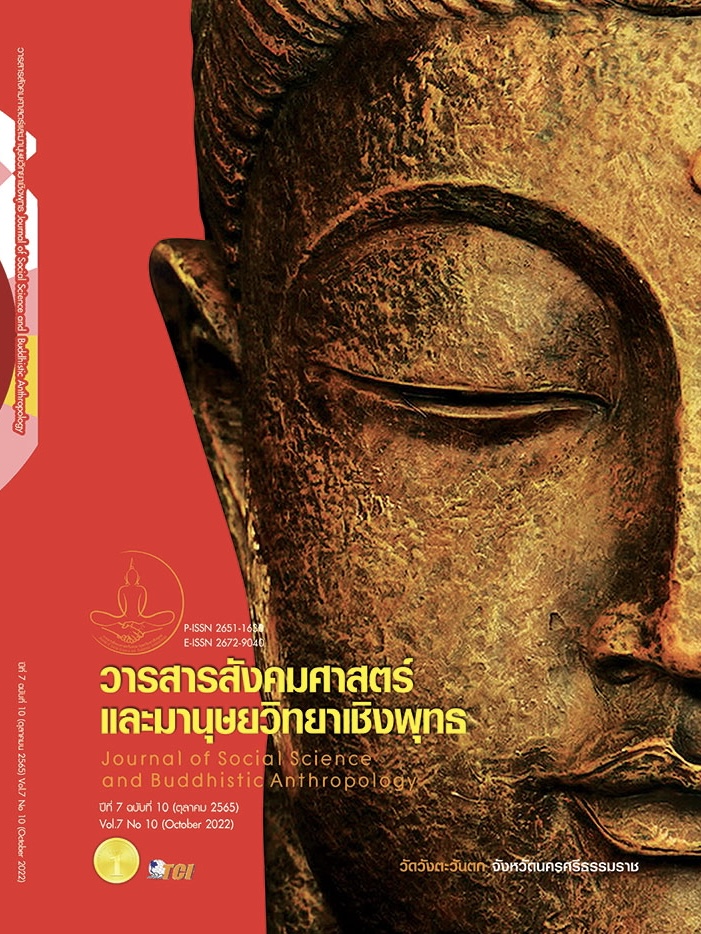MANAGEMENT MODEL OF COMMUNITY FOREST AND WATER SOURCE OF GRASSROOTS COMMUNITY IN THE MOUNTAINS AREA BY THE KING'S PHILOSOPHY IN BAN AE-AO, VILLAGE NO. 1 CHAEM LUANG SUB-DISTRICT KALAYANIVADHANA DISTRICT CHIANG MAI PROVINCE
Keywords:
Community Forest Management Model, Foundation Community, King's PhilosophyAbstract
The objectives of this research article were to 1) study the general condition of community forest management, watershed communities, and foundations in the highlands according to the King's science. 2) develop a watershed community forest management model; and 3) present a watershed community forest management model. It is qualitative research. Focus on field research and participatory research Key informants were community leaders, village committees, community philosophers/spiritual leaders. Pakakenya Ethnic Group, Ban Ae-Ao, Village No. 1, Chaem Luang Sub-district, Kalayanivadhana District Chiang Mai Province, 16 monk/person by using an interview form and a questionnaire to analyze descriptive statistical data/person by using an interview form and to analyze descriptive statistical data . The results of the research were as follows: 1) Watershed community forest management Ban Ae-Ao according to the King's Philosophy. The working principle of seizing common interests. and conservation management approaches as the basis in the process of developing watershed community forest management by using the belief system which is the cultural basis of the community and the power of the group in the form of a committee It is an important mechanism for determining the relationship of people in the community in utilizing the community forest. 2)The community has adopted the approach of the King's Philosophy for Sustainable Development as a guideline. By manually starting and lead to self-sufficiency in 3 forms: 1. The pattern of dependence and use of diverse forests 2.A model of community forest management in watersheds according to the King's Philosophy of Chiang Mai Province with ecotourism; 3) Proposed a model for community forest management. The Ban Ae-Ao watershed community forest management model was proposed in accordance with the King's Philosophy according to the participatory planning process (AIC), which made it aware of the villagers' needs in solving problems and developing the community. Research Recommendation, leaders should use the monthly village forum process. To bring the topic of watershed community forest management.
References
คณะกรรมการพัฒนาการเศรษฐกิจและสังคมแห่งชาติ. (2560). “แผนพัฒนาเศรษฐกิจและสังคม แห่งชาติ ฉบับที่12 พ.ศ. 2560 - 2564”. กรุงเทพมหานคร: คณะกรรมการพัฒนาการเศรษฐกิจและสังคมแห่งชาติ.
จักรพงษ์ พวงงามชื่น. (2556). การพัฒนารูปแบบการมีส่วนร่วมของประชาชนในการจัดการป่าชุมชน. วารสารวิจัยและพัฒนา มจร, 36(2), 233-239.
เดือนนภา ภู่ทอง. (2561). การจัดการป่าชุมชนเพื่อความยั่งยืนโดยการใช้กระบวนการมีส่วนร่วมสาธารณะ และจารีตประเพณีท้องถิ่นในพื้นที่ภาคเหนือ. วารสารนวัตกรรมการบริหารและการจัดการ, 6(2), 88-89.
ทัชชวัฒน์ เหล่าสุวรรณ และคณะ. (2553). บทบาทในการส่งเสริมและพัฒนาป่าชุมชนแบบมีส่วนร่วมขององค์กรปกครองท้องถิ่น จังหวัดมหาสารคาม. มหาสารคาม: มหาวิทยาลัยราชภัฎมหาสารคาม.
ธีรทัศน์ โรจน์กิจจากุล และพระสมุห์อุทัย (มะโนรัตน์). (2561). การพัฒนารูปแบบการมีส่วนร่วมของประชาชน ในการอนุรักษ์และการจัดการป่าชุมชน. กรุงเทพมหานคร: มหาวิทยาลัยจุฬาลงกรณราชวิทยาลัย.
ภาวดี ทะไกรราช. (2561). การจัดการป่าชุมชนในพื้นที่ชั้นคุณภาพลุ่มน้ำชั้นที่ 3 จังหวัดศรีสะเกษโดยการมีส่วนร่วมของประชาชน. วารสารวิชาการ, 12(3), 115-118.
สมเกียรติ อุ่นท้าว. (2549). การใช้ภูมิปัญญาท้องถิ่นของประชาชนบ้านฝาง อำเภอกระนวน จังหวัดขอนแก่นในการอนุรักษ์ป่าชุมชน. ขอนแก่น: มหาวิทยาลัยขอนแก่น.
สัญญา วิวัฒน์. (2549). ทฤษฎีและกลยุทธ์การพัฒนาสังคม (พิมพ์ครั้งที่ 6 ฉบับปรับปรุง). กรุงเทพมหานคร: สำนักพิมพ์แห่งจุฬาลงกรณ์มหาวิทยาลัย.
สำนักงานจังหวัดเชียงใหม่ กลุ่มงานยุทธศาสตร์และข้อมูลเพื่อการพัฒนาจังหวัด. (2563). บรรยายสรุปจังหวัดเชียงใหม่. เรียกใช้เมื่อ 30 มีนาคม 2563 จาก https://www. chiangmai.go.th/managing/public/D8/8D12Nov2020103220.pdf
อคิน รพีพัฒน์. (2547). การมีส่วนร่วมของประชาชนในงานพัฒนา. กรุงเทพมหานคร: ศูนย์การศึกษานโยบายสาธารณสุขสิ่งแวดล้อม บัณฑิตวิทยาลัย มหาวิทยาลัยเชียงใหม่.
อัจฉรา สโรบล. (2553). กระบวนการมีส่วนร่วมของชุมชนกับโครงการพัฒนา. ใน ดุษฎีนิพนธ์ศิลปศาสตรดุษฎีบัณฑิต สาขาวิชาบ้านและชุมชน. มหาวิทยาลัยเชียงใหม่.
Downloads
Published
How to Cite
Issue
Section
License
Copyright (c) 2022 Journal of Social Science and Buddhistic Anthropology

This work is licensed under a Creative Commons Attribution-NonCommercial-NoDerivatives 4.0 International License.








